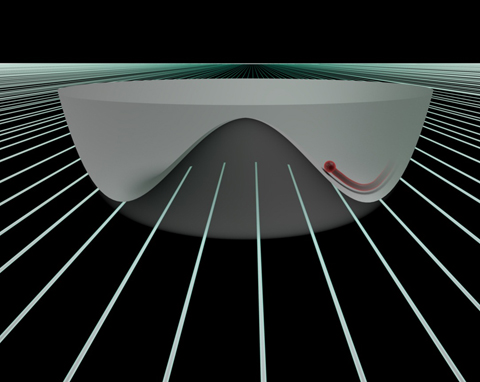Physicists have detected Higgs excitations near absolute zero. In a low-dimensional system containing ultracold atoms, the team was able to detect Higgs-type excitations at the transition phase of matter.
 Illustration of the Higgs excitation in a two-dimensional system. The dynamics of the Higgs excitation (red sphere) is described by an oscillation in a ‘sombrero’-shaped potential. Graphic: MPQ, Quantum Many-Body Division
Illustration of the Higgs excitation in a two-dimensional system. The dynamics of the Higgs excitation (red sphere) is described by an oscillation in a ‘sombrero’-shaped potential. Graphic: MPQ, Quantum Many-Body Division
Physicists belonging to Quantum Many-Body Division of the Max-Planck-Institute of Quantum Optics, Harvard University and the California Institute of Technology jointly performed the study and were able to identify Higgs excitations experimentally.
A sudden breaking of symmetry plays an important role in phase transitions that modify the complete state of a system. When cooled below the Curie-temperature, the atomic magnets that are in a ferromagnetic material align spontaneously. When this system is excited to a collective oscillation, a coordinated movement occurs, which leads to a special kind of excitations called as Higgs excitations. When such excitations play a role in elementary particles, they are called as Higgs-particles.
Higgs excitations decay within a short period and hence are difficult to detect. However, the team of physicists identified these excitations. As part of the experiment, they initially cooled the rubidium atoms to near absolute zero temperatures. Ultracold atoms were then loaded in an optical lattice of two-dimensions, which was formed by interfering laser beams.
Different states of matter can be realized by ultracold atoms in these lattices. A Mott insulator or highly ordered state develops under very intense optical lattices. Single atoms occupy each lattice site. When the intensity of the lattice is decreased, it leads to a phase transition to a superfluid. Here, all the atoms belong to a single field and form one extended quantum mechanical wave. When their equilibrium is disturbed, Higgs excitations occur.
The two-dimensional system’s parameters were set such that the quantum gas was close to the transition phase between a superfluid and a Mott insulator. The lattice intensity was then gently modulated to create Higgs excitations. Using a very sensitive method, the physicists detected small peaks in the distribution of temperature.
The physicists interpreted that the generation of Higgs excitations got resonantly enhanced when the intensity modulation frequency matched the Higgs excitation’s oscillation frequency. This led to more energy transfer and increase in temperature. When near a quantum phase transition, a ‘softening’ of the Higgs excitation occurs.
Manuel Endres, a senior researcher, stated that a phenomenon that cannot be precisely calculated has been detected. This increases the importance of the observations made in the study.